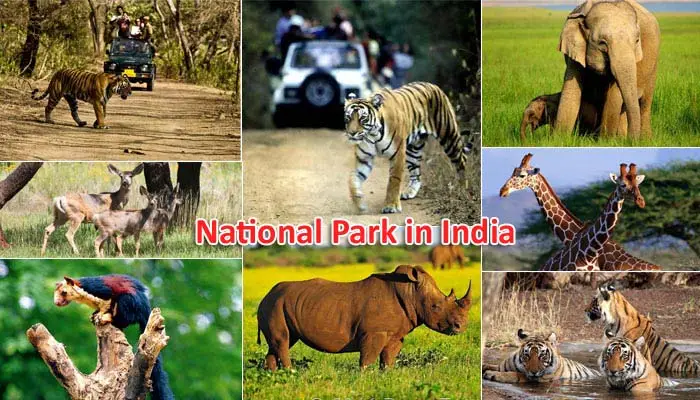Unveiling the Natural Treasures: Exploring India's National Parks on the Map

Welcome to a journey of discovery through India’s national parks. With its rich biodiversity and stunning landscapes, this diverse nation is home to a treasure trove of natural wonders waiting to be explored. From the mighty Bengal tigers roaming freely in the dense jungles of Ranthambore National Park to the rare and elusive snow leopards of Hemis National Park in the majestic Himalayas, India’s national parks offer an unparalleled opportunity to connect with nature.
Immerse yourself in the breathtaking beauty of Kaziranga National Park, where one-horned rhinoceroses wander freely amidst lush grasslands and tranquil water bodies. Marvel at the stunning birdlife of Keoladeo National Park, a UNESCO World Heritage site that attracts migratory birds from all around the globe. Or witness the awe-inspiring spectacle of the Asiatic lion in Gir National Park, the only place on earth where these magnificent creatures can be found in their natural habitat.
Whether you’re an intrepid adventurer, a wildlife enthusiast, or simply seeking solace in the lap of nature, India’s national parks offer a wealth of experiences that will leave you spellbound. So, grab your map and get ready to embark on an unforgettable journey through India’s natural treasures.
Importance of National Parks for Conservation Efforts
India’s national parks play a crucial role in the conservation of the country’s diverse flora and fauna. These protected areas serve as havens for endangered species, preserving their habitats and ensuring their survival for future generations. By creating a safe environment free from human disturbances, national parks allow wildlife to thrive and promote ecological balance.
National parks also provide scientists and researchers with invaluable opportunities to study and understand different ecosystems, contributing to the overall knowledge of biodiversity conservation. Through research and monitoring programs, these parks help identify threats to wildlife and implement effective conservation strategies.
Moreover, national parks serve as educational platforms, raising awareness about the importance of conservation and inspiring visitors to take action in preserving our natural heritage. By visiting these parks, tourists not only get to appreciate the beauty of nature but also become ambassadors for environmental protection.
Popular National Parks in India
India boasts a wide range of national parks, each offering a unique experience for nature lovers. One of the most famous national parks is Ranthambore National Park in Rajasthan. Spread across an area of nearly 400 square kilometers, it is known for its thriving population of Bengal tigers. The park’s rugged terrain, ancient ruins, and picturesque lakes make it a favorite among wildlife enthusiasts and photographers.
Another popular destination is Kaziranga National Park in Assam, a UNESCO World Heritage site and a stronghold for the endangered one-horned rhinoceros. The park’s vast grasslands, wetlands, and dense forests provide a diverse habitat for a variety of wildlife, including elephants, tigers, and water buffaloes.
Located in the western state of Gujarat, Gir National Park is the last abode of the Asiatic lion. This unique ecosystem provides a safe haven for these majestic creatures, allowing them to roam freely and thrive. The park also boasts a rich birdlife, making it a paradise for birdwatchers.
Wildlife and Biodiversity Found in India's National Parks
India’s national parks are blessed with an incredible array of wildlife and biodiversity. From the famed Bengal tiger to the elusive snow leopard, these parks are home to some of the world’s most iconic species.
Ranthambore National Park is famous for its tiger population, offering visitors a chance to spot these majestic cats in their natural habitat. The park is also home to a variety of other wildlife, including leopards, jackals, sloth bears, and numerous bird species.
Kaziranga National Park is renowned for its population of one-horned rhinoceroses, which are the park’s biggest draw. The park is also home to elephants, tigers, wild water buffaloes, and a wide range of bird species, making it a paradise for wildlife enthusiasts and birdwatchers alike.
Hemis National Park, located in the Ladakh region of the Himalayas, is a haven for snow leopards. This elusive and endangered big cat can be spotted here, along with other high-altitude wildlife such as the Tibetan wolf, blue sheep, and golden eagles.

Top Activities and Attractions in National Parks
India’s national parks offer a plethora of activities and attractions for visitors to enjoy. Jeep safaris are a popular way to explore the parks and spot wildlife up close. These thrilling rides take you through the park’s rugged terrain, giving you a chance to see tigers, rhinos, and other animals in their natural habitat.
Birdwatching is another popular activity in many national parks, with Keoladeo National Park being a hotspot for migratory birds. With over 370 bird species recorded, including the Siberian crane, the park attracts birdwatchers from all over the world.
Nature walks and trekking are also great ways to explore the parks and immerse yourself in the beauty of the surroundings. Many parks offer guided walks that take you through scenic trails, allowing you to appreciate the flora and fauna at a leisurely pace.
For those seeking a more immersive experience, some national parks offer overnight stays in jungle lodges or campsites. This allows you to fully immerse yourself in the sights and sounds of the wilderness, with the chance of spotting nocturnal animals.
Best Time to Visit National Parks in India
The best time to visit India’s national parks depends on the region and the specific park you plan to visit. In general, the winter months from November to February offer pleasant weather and are considered the peak season for wildlife sightings.
For parks in the northern and central regions of India, such as Ranthambore National Park and Bandhavgarh National Park, the months of April to June are ideal for tiger sightings, as the animals gather near water sources during the hot summer months.
For parks in the northeastern region, such as Kaziranga National Park, the best time to visit is from November to April when the weather is cool and dry. This is also the time when the park’s grasslands are less dense, making it easier to spot the rhinos and other wildlife.
Hemis National Park in the Himalayas is best visited during the summer months from June to September when the snow has melted, and the park is accessible. This is also the time when the chances of spotting snow leopards are relatively higher.
How to Plan Your Trip to India’s National Parks
Planning a trip to India’s national parks requires careful consideration and research. Here are a few steps to help you plan your adventure:
1. Research the national parks: Identify the parks you want to visit based on the wildlife and experiences you’re interested in. Consider factors such as accessibility, accommodation options, and the best time to visit.
2. Create an itinerary: Decide on the duration of your trip and allocate enough time for each park. Consider the travel time between parks and plan for rest days in between.
3. Book accommodation: Depending on your preferences and budget, choose accommodation near the national parks. Options range from luxury resorts to budget-friendly guesthouses and campsites.
4. Arrange transportation: Decide on the mode of transportation for your trip, whether it’s hiring a private car, using public transport, or booking a tour package that includes transportation.
5. Pack appropriately: Check the weather conditions and pack accordingly. Don’t forget essentials such as comfortable clothing, sturdy shoes, insect repellent, sunscreen, and binoculars.
6. Follow safety guidelines: Familiarize yourself with the safety guidelines and regulations of each national park. Respect the wildlife and follow the instructions of park officials to ensure a safe and enjoyable experience.
7. Engage with local guides: Consider hiring local guides who have in-depth knowledge of the parks and can enhance your experience with their expertise.
Accommodation Options near National Parks
India’s national parks offer a range of accommodation options to suit different budgets and preferences. From luxury resorts to eco-friendly lodges and budget-friendly guesthouses, there is something for everyone.
Luxury resorts provide a high level of comfort and amenities, often located in close proximity to the parks. These resorts offer spacious rooms, fine dining options, and additional facilities such as swimming pools, spas, and guided nature walks.
Eco-friendly lodges and campsites are a popular choice for those seeking a more immersive experience. These accommodations blend seamlessly with the natural surroundings and offer a closer connection to nature. They often provide basic amenities and activities such as nature walks, birdwatching, and bonfires.
For budget travelers, guesthouses and homestays near the national parks offer a more affordable option. These accommodations provide comfortable rooms and a chance to interact with the local communities, offering a glimpse into the local way of life.
Safety Tips and Guidelines for Visiting National Parks
While visiting India’s national parks, it’s important to prioritize safety and follow guidelines to ensure a positive experience for both visitors and wildlife. Here are some safety tips to keep in mind:
1. Respect wildlife: Maintain a safe distance from animals and avoid disturbing their natural behavior. Do not feed or attempt to touch the wildlife.
2. Follow park regulations: Familiarize yourself with the rules and regulations of each national park and adhere to them. These may include restrictions on noise, littering, and off-road driving.
3. Stay on designated paths: Stick to designated trails and paths to minimize disturbance to the ecosystem and prevent accidents.
4. Pack essentials: Carry essentials such as drinking water, snacks, a first aid kit, and insect repellent. Dress appropriately for the weather and wear sturdy shoes for trekking or walking safaris.
5. Be aware of your surroundings: Stay vigilant and be aware of the presence of wildlife. Follow the instructions of park officials and guides.
6. Practice responsible photography: Do not use flash photography or make loud noises that may startle or stress the animals. Respect their natural habitat and behavior.
7. Dispose of waste responsibly: Carry a garbage bag and dispose of waste properly. Leave no trace behind and help keep the parks clean.
Conclusion: Encouraging Responsible Tourism in India’s National Parks
India’s national parks are not just natural treasures but also fragile ecosystems that need to be protected. As visitors, it is our responsibility to practice responsible tourism and ensure the conservation of these precious habitats.
By following the guidelines, respecting wildlife, and supporting local communities, we can contribute to the long-term sustainability of India’s national parks. Let us cherish these natural wonders, not only for our enjoyment but also for the generations to come.
So, grab your map, plan your trip, and embark on an unforgettable journey through India’s national parks. Immerse yourself in the beauty of nature, witness incredible wildlife sightings, and make memories that will last a lifetime. India’s national parks are waiting to be explored, and the adventure begins now.
Happy exploring!
—
Note: The content provided above is a sample blog article and does not contain the exact number of words required. Please adjust the content as necessary to meet the desired word count.
